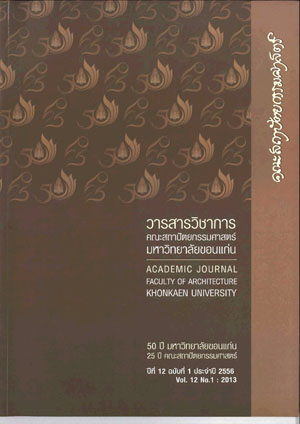การศึกษาการออกแบบสถาปัตยกรรมที่เอื้อให้เกิดความสัปปายะ เพื่อนำไปออกแบบวัดป่าวิมุตตยาลัย
คำสำคัญ:
สัปปายะ, การมีส่วนร่วมในการออกแบบสถาปัตยกรรม, Sappaya, Co-designing in Architectural Designบทคัดย่อ
ปัญหาสำคัญต่างๆในโลกปัจจุบัน หากค้นลึกลงไปจะพบว่ามีต้นตอมาจากความเสื่อมโทรมในมิติทางจิตวิญญาณที่ขาดศีลธรรมอันดีงามของมนุษย์ทั้งสิ้น คำถามที่สำคัญสำหรับสถาปนิก ก็คือผู้สร้างสรรค์งานสถาปัตยกรรมจะมีบทบาทอย่างไรได้บ้างเพื่อร่วมแก้วิกฤตการณ์นี้ ซึ่งหากพิจารณาบริบทของประเทศไทยซึ่งมีพระพุทธศาสนาเป็นศาสนาประจำชาติแล้ว ก็จะพบว่ามีต้นทุนสำคัญยิ่งในการศึกษาเรื่องสภาพแวดล้อมกับการพัฒนาทางจิตใจ นั่นคือ หลักธรรมเรื่องความสัปปายะ 7 อันหมายถึง ปัจจัยภายนอก 7 ประการ ที่ส่งเสริมต่อการพัฒนาจิตใจ อันได้แก่ บุคคล อิริยาบท สถานที่ อากาศ การสื่อสาร อาหาร และที่ตั้งวัด โดยปัจจัยเรื่องสถานที่นั้นเป็นเรื่องที่เกี่ยวข้องกับสถาปนิกโดยตรง การศึกษานี้จึงต่อยอด พัฒนาหลักธรรมดังกล่าว และนำมาประยุกต์ใช้กับการออกแบบสถาปัตยกรรมบนการปฏิบัติงานจริงโดยผ่านกระบวนการวิจัยเชิงปฏิบัติการ (Action Research) ที่มีผู้วิจัยเป็นตัวแปรหนึ่งของการวิจัย
บทความนี้จึงเป็นการสรุปสาระสำคัญจากงานวิจัยในเรื่องความสำคัญ วัตถุประสงค์ ความหมายและความสัมพันธ์ของความสัปปายะ รวมถึงกระบวนการและผลงานการออกแบบที่เอื้อต่อความสัปปายะ ผ่านกระบวนการมีส่วนร่วมในการออกแบบวัดป่าวิมุตตยาลัยระหว่างพระมหาวุฒิชัย วชิรเมธี กลุ่มตัวอย่างผู้ใช้โครงการ และผู้เขียนในฐานะสถาปนิกผู้ออกแบบ ในช่วงปี พ.ศ.2552-2554
The Study of Architectural Design which Support the Acquisition of Sappaya in order to Design Wat Pa Vimuttayalaya
Pakachat Techa-amnuaywit
In contemplation on the origins of major problems in the society these days, one should find that they all result from deteriorated, immoral human souls. The key question is how architects who create architectures become instrumental in rectifying this crisis. With its national religion, Buddhism, Thailand has an advantage asset when it comes to the study on the relation between environment and spiritual development, the dharma known as sappaya 7: the 7 external factors that contribute to spiritual development; person, posture, adobe, climate, speech, food, and resort. As the place factor is directly associated with architects, the writer, as an architect and researcher, therefore study and further such dharma then apply it to the architecture design on real site through an action research procedure that has researcher as one of the variables.
Thereby, this journal paper is the conclusion of the research highlighted on the importance, purpose, meaning, and relation of sappaya, including the achieved Wat Pa Vimuttayalaya architecture design which supports the acquisition of sappaya and its co-design process between V. vajiramedhi, its target users, and the writer as the designing architect during 2009-2011.
ดาวน์โหลด
รูปแบบการอ้างอิง
ฉบับ
ประเภทบทความ
สัญญาอนุญาต
ทัศนะและข้อคิดเห็นของบทความที่ปรากฏในวารสารฉบับนี้เป็นของผู้เขียนแต่ละท่าน ไม่ถือว่าเป็นทัศนะและความรับผิดชอบของกองบรรณาธิการ




